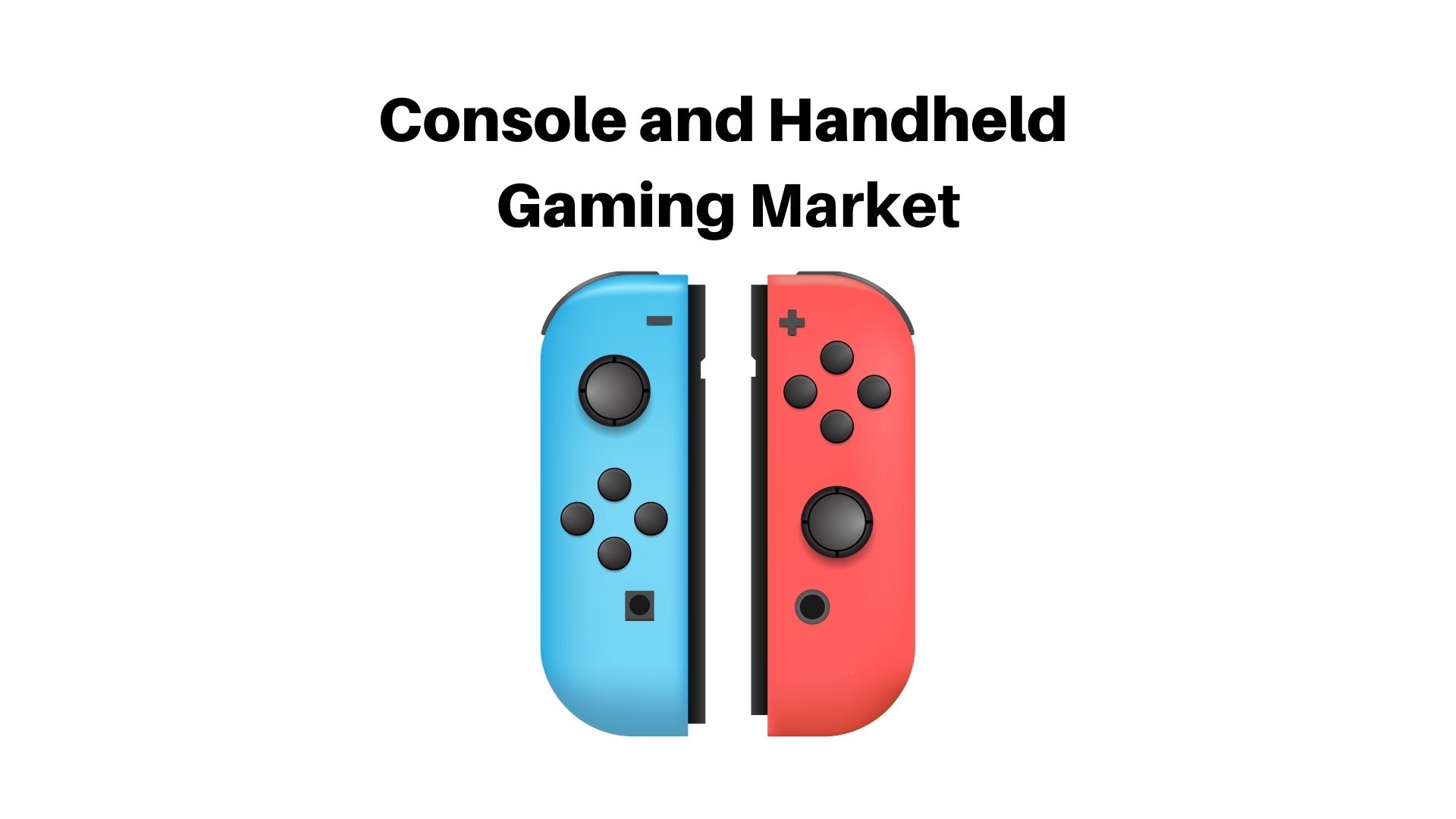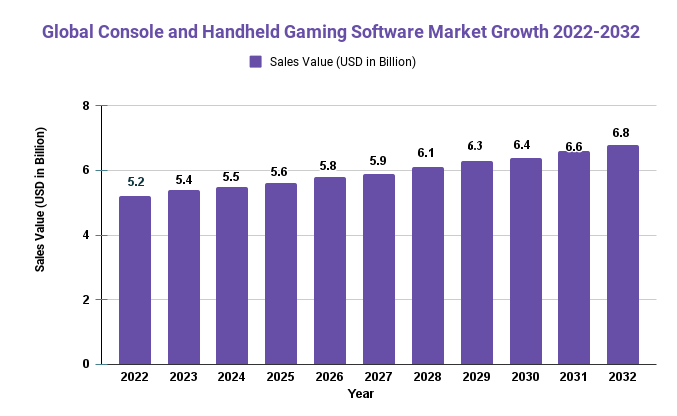Console and Handheld Gaming Software Market Size USD 6.8 Bn by 2032| at a CAGR 2.6%

Page Contents
Market Overview
Published Via 11Press: The Global Console and Handheld Gaming Software Market is forecast to reach USD 6.8 Bn by 2032 from its current value of USD 5.23 Bn in 2022, growing at a compound annual growth rate (CAGR) of 2.6% between 2023-2032.
The global console and handheld gaming software market is a vibrant and rapidly developing industry. This sector includes video games designed for consoles like PlayStation, Xbox, Nintendo as well as handheld devices like smartphones and tablets. The rising popularity of online gaming, demand for high-quality content, as well as growing adoption of virtual reality (VR) and augmented reality (AR) technologies are some of the primary factors driving growth within this sector.
The console segment currently holds the largest market share due to the growing appeal of console games among gamers. Furthermore, advanced technologies like virtual reality (VR) and augmented reality (AR) have further fuelled this growth trajectory.
Meanwhile, the handheld gaming software market is experiencing rapid expansion due to the growing popularity of smartphones and tablets. Mobile gaming has become a go-to choice among casual gamers, and with affordable devices and low-cost data plans becoming more accessible, this segment's growth has been further amplified.

Drivers, trends, and challenges have an impact on market dynamics, which can impact businesses. Request for PDF sample report
Key Takeaways
- Between 2022 and 2032, the global console and handheld gaming market is projected to experience a compound annual growth rate of 2.6%.
- Due to the growing demand for premium content and advanced gaming consoles, console gaming accounts for the majority of this market.
- Due to key market players and rising disposable income levels, Asia Pacific is currently the dominant region in this industry. Furthermore, this region boasts an ever-increasing population of gamers.
- The market for online gaming has seen a meteoric rise due to the growing popularity of multiplayer games and cloud gaming technology. Electronic Arts, Microsoft Corporation and Sony Corporation are key players in this space; Tencent Holdings Ltd. and Nintendo Co. Ltd. also play an important role.
Regional Snapshot
The global console and handheld gaming software market are divided into North America, Europe, Asia Pacific, Latin America, and Middle East & Africa. Asia Pacific dominates this space due to the presence of key players, rising disposable income, and expanding gamer population there. North America and Europe also hold significant market shares due to advanced gaming technology as well as high demand for content produced on consoles and handhelds.
Drivers
- Technological Advancements: As technology has progressed, console and handheld gaming software has become more sophisticated, immersive, and visually pleasing. This has driven up demand for these products as gamers seek out the newest experiences.
- Growing Popularity of Esports: Esports have rapidly grown into a major industry over the last few years, with millions tuning in to watch competitive gaming events. This has created an enormous market for gaming software – particularly popular titles like Call of Duty, Fortnite, and League of Legends.
- Rise of Mobile Gaming: The popularity of mobile gaming has also contributed to the growth of console and handheld gaming software. Many gamers enjoy playing games on their smartphones or tablets, but many crave more immersive experiences that can only be provided by consoles and handhelds.
- Increasing Access to Online Gaming: Online gaming has become a major component of the gaming industry, with millions playing popular titles like World of Warcraft, Minecraft, and Fortnite from their computers or phones. This has created an enormous demand for console and handheld gaming software as players strive for the best experiences when playing these online.
- Global Population Growth: As the global population continues to increase, so too does the number of people interested in gaming. This has created a massive market for gaming software, particularly within emerging nations like China and India.
Restraints
- High Cost: Gaming consoles and handheld devices can be pricey, which may put off potential customers. Furthermore, gaming software costs can be high which limits the selection of games players have access to purchase and play.
- Competition from Mobile Gaming: Mobile gaming has seen a meteoric rise in popularity over the last few years, as more gamers opt to play on their smartphones or tablets instead of investing in gaming consoles or handheld devices. This has created competition for console and handheld gaming software companies as players seek more cost-effective accessible options.
- Limited Access to Exclusive Titles: Many popular console and handheld gaming titles are exclusive to certain platforms, which may limit their appeal for some gamers. For instance, those interested in playing certain titles must purchase a specific console or handheld device to gain access to them.
- Short Product Lifecycles: Gaming consoles and handheld devices tend to have short product lifespans, with new models and versions released regularly. This can present a challenge for gamers who must upgrade their hardware frequently in order to stay abreast of the newest games and features.
Opportunities
- Developments in Virtual and Augmented Reality Technology: Virtual reality technology is opening up new prospects for console and handheld gaming software, providing immersive and interactive experiences not possible with traditional gaming programs.
- Expansion into Emerging Markets: Emerging markets such as China, India, and Brazil have an increasingly large middle class that is interested in gaming. This presents a great opportunity for console and handheld gaming software companies to increase their customer base and boost revenues.
- Cross-Platform Integration: Cross-platform integration allows players to access their gaming accounts across multiple devices, such as consoles, handhelds, and smartphones. This provides a more streamlined and convenient gaming experience for gamers which may increase engagement and loyalty levels.
- Subscription-Based Models: Subscription-based models provide players with access to a library of games at an affordable monthly fee, making it more affordable and accessible for those who may not have the funds to buy individual games or consoles outright.
- Integration with Social Media: Connecting console and handheld gaming software companies to social media platforms can offer companies a way to reach a broader audience, increasing engagement with their games. Furthermore, these platforms give players an opportunity to connect and interact with one another, which in turn enhances the gaming experience.
Challenges
- Competition from Other Forms of Entertainment: The gaming industry faces intense competition from other forms of entertainment, such as movies, TV shows, and streaming services. This can make it difficult for gaming companies to attract and retain customers.
- Piracy and Copyright Infringement: Piracy and copyright infringement continue to be major challenges for the gaming industry. Pirated copies of games can easily be downloaded online, which drastically reduces sales and revenues for gaming companies.
- Hardware Limitations: Console and handheld gaming software is heavily dependent on hardware, so any limitations in that regard could significantly restrict a game's capabilities or performance. As a result, gaming companies may find it increasingly difficult to create and distribute high-quality titles.
- The difficulty of Generating Successful Titles: Generating successful titles can be a time-consuming and costly endeavor, even for established gaming companies that struggle to create hit games. This makes it difficult for these businesses to generate revenue and remain competitive.
- Ethical and Legal Matters: Gaming raises ethical and legal issues, such as addiction, violence, and gambling. These can present gaming companies with challenges in regard to regulatory compliance and public relations.
Recent Developments
- In 2021, Microsoft Corporation acquired ZeniMax Media – parent company to Bethesda Softworks – to bolster its gaming content portfolio.
- Electronic Arts also revealed the launch of EA Play, their cloud gaming service, in 2020.
- In 2019, Google unveiled its cloud gaming service, Stadia. This allows gamers to access games on any device with an internet connection.
- Tencent Holdings Ltd. acquired a majority stake in Path of Exile developer Grinding Gear Games in 2018.
Key Market Segments
Type
- Console Gaming
- Handheld Gaming
Application
- Console Gaming
- Handheld Gaming
Key Market Players
- Sony Interactive Entertainment LLC (USA)
- Activision Blizzard Inc (USA)
- Electronic Arts Inc (USA)
- Nintendo Co. Ltd (Japan)
- Microsoft Corporation (USA)
- Ubi Soft Entertainment S.A (France)
- Crystal Dynamics#Inc (USA)
- Giant Sparrow (USA)
- Kojima Productions Co.#Ltd (Japan)
- Next Level Games Inc (Canada)
- Playground Games (UK)
- Respawn Entertainment#LLC (USA)
- Infinite Fall (USA)
- Bethesda Game Studios (USA)
- Guerrilla B.V (The Netherlands)
- Mercury Steam Entertainment (Spain)
Report Scope
| Report Attribute | Details |
| The market size value in 2022 | USD 5.2 Bn |
| Revenue forecast by 2032 | USD 6.8 Bn |
| Growth Rate | CAGR Of 2.6% |
| Regions Covered | North America, Europe, Asia Pacific, Latin America, and Middle East & Africa, and Rest of the World |
| Historical Years | 2017-2022 |
| Base Year | 2022 |
| Estimated Year | 2023 |
| Short-Term Projection Year | 2028 |
| Long-Term Projected Year | 2032 |
Frequently Asked Questions
Q: What is the console and handheld gaming software market?
A: The console and handheld gaming software market refer to the market for gaming software that is specifically designed for use on gaming consoles and handheld devices.
Q: What are some popular gaming consoles?
A: Some popular gaming consoles include the PlayStation, Xbox, and Nintendo Switch.
Q: What are some popular handheld gaming devices?
A: Some popular handheld gaming devices include the Nintendo 3DS and the PlayStation Vita.
Q: How big is the console and handheld gaming software market?
A: The console and handheld gaming software market is a multi-billion dollar industry, with millions of players around the world.
Q: What types of games are available for console and handheld devices?
A: A wide variety of games are available for console and handheld devices, including action, adventure, role-playing, sports, and puzzle games.
Q: How do console and handheld gaming software companies make money?
A: Console and handheld gaming software companies make money by selling gaming software and hardware, as well as through subscriptions and in-game purchases.
Q: What are some trends in the console and handheld gaming software market?
A: Some current trends in the console and handheld gaming software market include the growth of virtual and augmented reality, the expansion into emerging markets, and the use of subscription-based models.
Q: How is the console and handheld gaming software market affected by the COVID-19 pandemic?
A: The COVID-19 pandemic has led to increased demand for console and handheld gaming software, as more people are spending time at home and looking for entertainment options. However, the pandemic has also disrupted supply chains and led to delays in product launches and releases.
The team behind market.us, marketresearch.biz, market.biz and more. Our purpose is to keep our customers ahead of the game with regard to the markets. They may fluctuate up or down, but we will help you to stay ahead of the curve in these market fluctuations. Our consistent growth and ability to deliver in-depth analyses and market insight has engaged genuine market players. They have faith in us to offer the data and information they require to make balanced and decisive marketing decisions.



